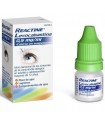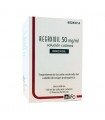Rhinocort 64 micrograms contains as the active substance budesonide, which belongs to a group of medicines called glucocorticoids and is used to reduce inflammation. Rhinocort 64 micrograms reduces inflammation of the nasal mucosa (inner part of the nose). Rhinocort 64 micrograms is used for the symptomic relief of allergic rhinitis produced by pollen and other allergens present in the air, such as dust mites, fungal spores or animal hair, in adults. Alleviates symptoms such as sneezing, itching, nasal congestion, nasal dripping. The highest level of protection may not be achieved during the first few days, so it is important to continue regular use to ensure the full therapeutic benefit. Your doctor should be consulted if symptoms do not improve or worsen after 7 days. This medicine should not be used continuously for more than 3 months unless your doctor tells you to.
ACTION AND MECHANISM
Glucocorticoid, with anti-inflammatory and antiallergic properties. Although the mechanism of action of glucocorticlides in rhinitis is not known exactly, it appears that both actions are linked to the ability of glucocorticoids to reduce the synthesis and release of inflammation and allergy mediators, such as histamine, prostaglandins and leukotriene, substances responsible for triggering and maintaining nasal symptoms (sneezing, itching, itching , rhinorrhea and nasal obstruction). Glucocorticoids inhibit the initial phase of the allergic reaction mediated by IgE and mast cells, as well as the emigration of cells from inflammation to nasal tissue. Also, like other glucocorticoids administered by inhalation, budesonid results in a decrease in the number of eosinophils and a decrease in bronchial reactivity. The intrinsic potency of budesonid, measured as affinity to the glucocorticoid receptor, is approximately 15 times that presented by prednisolone.
Elderly
The safety and efficacy of the use of nasal corticosteroids in the elderly have not been established, however, no specific geriatric problems are forerated that limit the usefulness of these medicinal products in the elderly. Precautionary use.
PATIENT ADVICE
- Periodic medical reviews are advised during prolonged treatments (several months) to evaluate the effectiveness of treatment and/or diagnose any changes in the nostrils (infection, nasal mucosa atrophy, perforation, nosebleeds etc).- The therapeutic effect is not immediate. Generally the maximum effect is evident after several days of uninterrupted treatment, especially in severe rhinitis.- Its effectiveness is greater with regular use.- Clean the nose before administration. Eventually, in the presence of nasal congestion a decongestant may be used to facilitate penetration, warning that adrenergic decongestants applied for more than 3-5 days may cause rebound congestion.- Patients with frequent nosebleeds should warn the doctor.
Contraindications
- [ALLERGY TO CORTICOIDES] or to any of the excipients contained in the formulation.- Untreated localized infection affecting the nasal mucosa.
Pregnancy
FDA Category C. Animal studies, using large doses of corticosteroids systemically, have recorded teratogenic, fetotoxic and intoxicated effects (abnormalities in fetal development, such as decreased body weight and delayed ossification and malformations such as cleft palate, etc.). There are no adequate and well-controlled studies in humans with intranasal budesonid. Human studies with systemic corticosteroids have not been able to confirm the teratogeny observed in animals. Children born to mothers who have received significant doses of corticosteroids during pregnancy should be carefully screened for signs of hypoadrenalism. Topical-nasal administration at recommended doses of these corticosteroids does not appear to produce significant systemic levels. During pregnancy there is a natural increase in endogenous corticosteroid production, so pregnant women will require a lower exogenous dose of corticosteroids and many will not even need corticosteroid treatment during pregnancy. The use of these medicines is only accepted in case of absence of safer therapeutic alternatives.
Pharmacokinetics
- Absorption:It is rapidly absorbed into the nasal mucosa. Part of the dose is swallowed. the systemic bioavailability of budesonid administered as a nasal suspension, with respect to the dosed amount, is 33%. In adults, the maximum plasma concentration following administration of 256 mmg of budesonid in suspension for nasal spray is 0.64 nmol/l and is reached at 0.7 hours. The area under the curve (AUC) after administration of 256 mmg of budesonid suspension for nasal spray is 2.7 nmol x h/l in adults, and 5.5 nmol x h/l in children, indicating superior systemic exposure in children.- Distribution: The volume of distribution of budesonid is approximately 3 l/Kg. Plasma protein binding ranges from 85-90%. Budesonid kinetics are proportional to the dose within the dose range of 64 to 256 micrograms daily.- Metabolism: Budesonid experiences a high degree of biotransformation (-90%) in the liver leading to metabolites of low glucocorticoid activity. The glucocorticoid activity of the main metabolites, 6bb-hydroxyibudesonide and 16aa-hydroxyprednisolone, is less than 1% compared to that of budesonide. The metabolism of budesonide is mainly mediated by CYP3A, belonging to the cytochrome P450 subfamily. Budesonid is not metabolized locally in the nasal mucosa.- Elimination: Hepatic clearance of budesonid is high (approximately 1.2 l/min) and its elimination half-life after i.v. administration ranges from 2 to 4 hours. Unchanged budesonide is not detected in urine. The metabolites are excreted, as such or in their conjugated form, mainly renally (70%); although with significantly reduced glucocorticoid activity compared to the original compound. Therefore, dose adjustment is not considered necessary in patients with renal impairment. All other inactive metabolites are eliminated with faeces. The onset of action may occur at 24 hours, although the maximum therapeutic effect is usually delayed several days.
Indications
- Symptomatic treatment of [SEASONAL ALLERGIC RINITIS], [PERENNIAL ALLERGIC RINITIS] or [VASOMOTOR RINITIS] in adults and children from 6 years of age. - [POLIPOS NASALES]. Symptomatic treatment of nasal polyps in adults, and prevention of them after polypectomy.
Breast feeding
It is not known whether this medicine is excreted with human milk. Although other systemic corticosteroids are excreted and can inhibit growth, interfere with endogenous corticosteroid production and produce other adverse effects in infants, topical-nasal administration at recommended doses of these corticosteroids does not appear to produce significant systemic levels, and therefore expected breast milk concentrations will also not be significant. Precautionary use.
Children
The safety and efficacy of the use of nasal budesonid in children under 6 years of age have not been established. Experience in ages 6 to 17 is limited. In a 4-week study, which included 406 patients aged 6 to 73 years, no statistically significant differences in ACTH-stimulated cortisol levels were observed, from baseline to after treatment, comparing active placebo treatment. In another 3-week study, which included 318 patients aged 12 to 67 years, no significant differences in urinary cortisol levels were found from placebo. In case of significant systemic absorption of nasal corticosteroids, adrenal suppression and stunting may occur in children, however, these effects have not been demonstrated with regular doses of other nasal corticosteroids. The results obtained in a 1-year study that included 313 patients aged between 6 and 17 years, together with data obtained with other budesonid formulations, make it possible to conclude that there is a measurable effect on growth in children, which is why their size should be regularly monitored. This drug may be a useful therapeutic alternative to oral corticosteroids in children over 6 years of age or older with seasonal rhinitis, as the intranasal route is associated with decreased systemic adverse effects. Accepted use in children 6 years of age or older; strict monitoring of children's growth and development in prolonged treatments is recommended.
RULES FOR PROPER ADMINISTRATION
the total daily dose can be given in one or two doses (morning or morning and night). Presentation 64 mcg: shake the container and press several times (5-10 times) until a uniform spray of the product begins to appear. If not used daily, it is necessary to reload the pump. In this case, it will be sufficient to perform a single pulsation in the air. Before application clean both nostrils thoroughly, shake the container and remove the brown lid and hold it upright, insert the applicator into a nostril and release the indicated doses. Repeat the operation in the other nostril. Replace the lid. It is advisable to clean the plastic parts regularly. To do this, remove the brown cap and remove the white nasal applicator and wash them with warm water, letting them dry completely before re-placing them.
Dosage
a) Seasonal allergic rhinitis, perennial allergic rhinitis, vasomotor rhinitis:- Adults and children over 6 years of age (nasal): depending on presentation, 64 or 100 mcg/12 hours (morning and evening) in each nostril or 128 or 200 mcg/24 hours (morning) in each nostril. Maintenance, 64 or 100 mcg/24 hours (morning) or 50 mcg/12 hours (minimum effective dose). Symptoms usually go away after several days of treatment, in some cases after a couple of weeks. Discontinue treatment if there is improvement in 3 weeks. In perennial allergic rhinitis, control symptoms, reduce the dose gradually every 2-4 weeks until a maintenance dose is instituted. The presentation "Aqua" is a nasal spray, with budesonid in aqueous suspension, which is administered without the need to use propellent. Treatment of seasonal rhinitis should be initiated, whenever possible, prior to exposure to allergen.b) Nasal polyposis/prevention after polypectomy (presentation 64 mcg/dose):- Adults and children over 6 years of age (nasal): 128 mcg (2 applications)/24 hours (morning) in each nostril or 64 mcg (1 application)/12 hours (morning and night) in each nostril. Once the desired clinical effects have been achieved, the maintenance dose should be reduced to the minimum necessary to control symptoms.
Precautions
Caution is recommended in case of:- [TUBERCULOSIS] pulmonary, [RESPIRATORY INFECTION] fungal or viral. Administration of budesonide to patients with active or chiescent tuberculosis, with untreated systemic fungal, bacterial or viral infections or with ocular herpes simplex should only be performed after careful assessment. If a fungal infection located in the nasopharynx occurs during treatment with nasal budesonide, discontinuation of treatment should be considered. Treatment with nasal budesonid may mask an underlying local infection.- In prolonged treatments the nasal mucosa should be inspected at least once a year. Cases of alteration of the nasal mucosa and more rarely perforation of the nasal septum, as well as increased intraocular pressure following the use of corticosteroids nasally, have been reported. Administration should be discontinued in case of nasal surgery or nasal trauma, as long as healing does not occur.- Occasionally, concomitant administration of an antihistamine may be necessary to improve the eye symptomatology produced by the allergy.- Maximum effects are obtained after several days of treatment.- The use of excessive doses, or long-term treatment with nasal glucocorticoids may trigger signs or symptoms of hyperadrenocorticism, suppression of hypothalamus-pituitary-adrenal axis function and/or suppression of growth in children. Special caution is recommended in patients previously treated with steroids systemically, as the transition to nasal budesonide administration may trigger the onset of adrenal insufficiency. In this case, systemic administration should be re-established and the necessary support measures taken; especially if stressful situations such as surgery, systemic infection etc. are additionally occurring. In addition, some patients may initially experience withdrawal symptoms such as joint and/or muscle pain, tiredness and depression. Contact of the product with the eyes should be avoided. In case of eye contact, the patient should wash them immediately with plenty of water.
ADVERSE REACTIONS
Side effects of this medicine are generally mild and transient. The most common alterations are:
- Otolaryngological:[NASAL IRRITATION] (3-9%), [SNEEZING], immediate sneezing attacks. In both cases the incidence was similar to placebo, and related to the drug and/or the vehicle of preparation. Occasionally, [CONGESTION NASAL], [EPISTAXIS] (3-9%), [RINORREA], [NASAL DRYNESS]. Rarely, [NASAL CANDIDIASIS], [CANDIDIASIS FARINGEA] (<1%). Exceptionally, after several months of treatments, ulceration of the nasal mucosa and [NASAL TABIQUE PERFORATION]. Cases of [DISGEUSIA] and [PAROSMIA] have been reported.
- Allergic/dermatological: rarely, [URTICARIA], [BRONQUIAL SPASM], [ANGIOEDEMA], [EXANTEMATIC ERUPTIONS], [SIMPLE HERPESVIRUS INFECTION].
- Neurological/psychological: rarely, [NERVIOSISMO].
- Eyepieces: Rarely, after prolonged use increased intraocular pressure, [CATARATAS] and [GLAUCOMA].
- Respiratory: [FARINGITIS], [TOS](3-9%). [DISNEA] and [RONQUERA] (<1%).
- Digestives: [DISPEPSIA], [MOUTH DRYNESS] (1-3%), [NAUSEAS] (<1%).
- Musculoskeletal (<1%): [MIALGIA], [OSTEOMUSCULAR PAIN].
If the recommended doses are exceeded for extended periods or in specially predisposed individuals symptoms of hypercorticism may occur.
Treatment should be discontinued in case of persistent nasopharyngeal irritation.




























